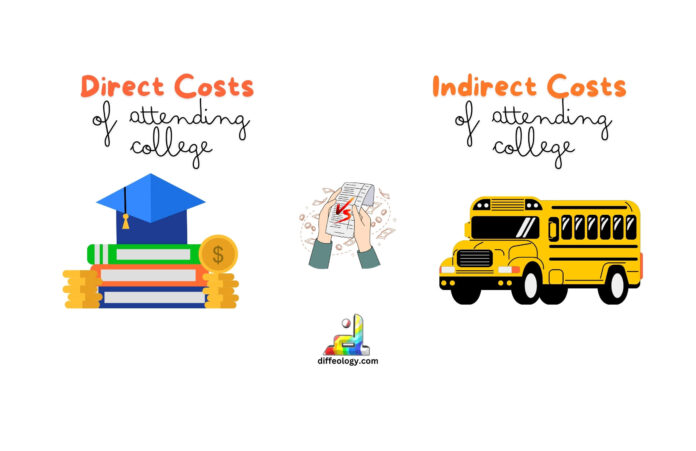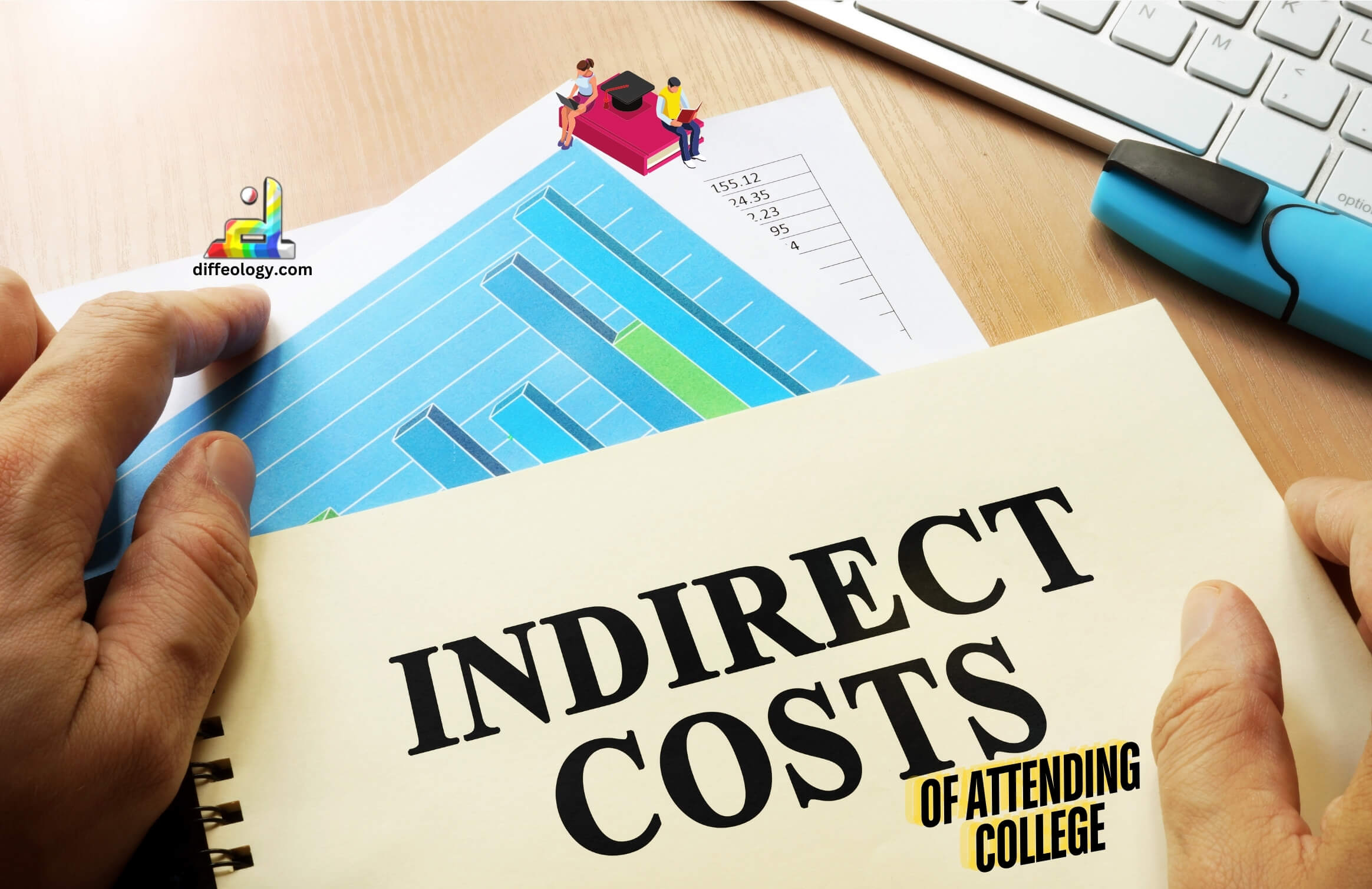It is true that going to college costs so much. Well, it’s because there are different kinds of expenses involved. You see, when you decide to go to college, you’re not just paying for tuition and books. There are some costs that are super easy to see, like the ones you pay directly, and then there are others that are a bit sneakier, called indirect costs. Let’s break it down and find out the Difference Between Direct Costs and Indirect Costs of Attending College!
Main Difference Between Direct Costs and Indirect Costs of Attending College
Direct costs of college are the must-pay expenses directly linked to your schooling, such as tuition and books, which you hand over to the college. Indirect costs, though, are like the side expenses you need to cover for living while you’re studying, such as where you stay, what you eat, and how you get around. Direct costs are like the upfront bill for your classes, while indirect costs are the extra things you gotta figure out how to handle while you’re hitting the books.
Direct Costs Vs. Indirect Costs of Attending College
What are Direct Costs of Attending College?
Direct costs are the things you gotta pay for that are directly linked to your education. It’s like the money you hand over to the college for them to teach you stuff. These costs include stuff like tuition fees for your classes, the books and materials you need for your courses, and sometimes additional fees for things like lab equipment or special facilities. Basically, direct costs are the essentials that you can’t skip out on if you wanna go to college and learn.
Read Also: Difference Between Broad Money and Narrow Money
When you pay direct costs, you’re basically buying your seat in class. It’s like saying, “Hey, I wanna learn this stuff, so here’s the money to cover my part.” The college usually tells you exactly how much you need to pay for these things, and they send you a bill for it. So, direct costs are pretty straightforward – you pay up, and in return, you get to attend classes and get all the educational stuff you need.
What are Indirect Costs of Attending College?
Indirect costs of going to college are like the extra things you need to spend money on while you’re studying, but they’re not directly connected to your classes. These are the costs for stuff like where you live, what you eat, how you get around, and all those little extras you might need. Think about it like this: while direct costs are the fees you pay to the college for your education, indirect costs are the expenses you face because you’re a college student.
Read Also: Overdraft vs Loan Easiest Solution Differentiate
Unlike direct costs, indirect costs can be a bit trickier to figure out because they’re not always as obvious. You gotta estimate how much you’ll spend on things like housing, food, transportation, and other personal stuff you might need while you’re at college. And since these costs can vary depending on where you live and your lifestyle choices, it’s important to plan ahead and budget wisely to make sure you’ve got enough to cover everything.
Comparison Table “Direct Costs Vs. Indirect Costs of Attending College”
| What They Cover | Pay for classes and books. | Cover living expenses. |
| Who Gets Paid | Go straight to college. | You pay for yourself. |
| What’s Clear | On your college bill. | Need more planning. |
| Fixed vs. Flexible | Stay mostly the same. | Change based on your choices. |
| Control Level | Can’t change them. | More say in them. |
| Paying Up | Like buying a ticket to class. | Managing your own pocket money. |
| Financial Aid Consideration | Affect how much help you get. | Affect how much help you get. |
| Impact on Your Wallet | Hit you at the start of each term. | Add up over time. |
| Short-Term vs. Long-Term | For now. | Affect your future too. |
| Connection to Learning | Help you study. | Support your lifestyle while studying. |
| Planning Ahead | Need budgeting too. | Require smart planning for the future. |
| Transparency | Clear-cut. | Need more calculation. |
| Responsibility | Handled by college. | You manage them yourself. |
| Mandatory vs. Optional | Necessary. | Depends on your choices. |
| Billing Method | Billed by the college. | Your personal expenses. |
| Room for Adjustment | Don’t change much. | Can be adjusted based on your lifestyle. |
| Contribution to Success | Essential for college enrollment. | Ensure you have what you need to succeed in college. |
Difference Between Direct Costs and Indirect Costs of Attending College in Detail
1. What They Are:
Direct costs of going to college are the things you gotta pay for that are directly connected to your education, like fees for classes, books, and stuff you need for labs. It’s basically the money you hand over to the college for them to teach you stuff. Indirect costs, on the other hand, are like the other things you need to spend money on while you’re at college, but they’re not directly linked to your classes. Think about things like where you live, what you eat, how you get around, and the extra things you buy for yourself.
2. Visibility:
Direct costs are pretty clear because the college tells you exactly how much you need to pay for classes and books, and they send you a bill for it. But indirect costs can be a bit trickier because they’re not always as obvious. You gotta figure out how much you’ll spend on stuff like housing, food, transportation, and other personal things you might need while you’re studying.
3. Payment Method:
Direct costs are usually paid straight to the college, either by cash, card, or with financial aid. It’s like paying for your seat in class. But indirect costs, well, you pay for those separately. It’s like paying for your own food, your place to live, and all those little extras you need to get by.
4. Fixed vs. Variable:
Direct costs stay pretty much the same all the time. Once you know how much your tuition and fees are, they don’t change much. But indirect costs can change a lot. They depend on where you choose to live, how you get around, and what kind of lifestyle you have while you’re at college.
5. Control:
You don’t have much say in direct costs because the college sets them, but you can control your indirect costs. You get to decide where you live, what you eat, and how you spend your money on personal stuff. So, you can kinda choose how much you spend on those things.
6. Financial Aid Application:
When colleges give out financial aid, they usually look at both direct and indirect costs. They wanna make sure you have enough money to cover everything you need for college, from classes to living expenses. So, they’ll consider both when they decide how much aid to give you.
7. Impact on Budgeting:
Direct costs are like the big chunks of your college budget that you gotta plan for. They’re the main things you need to pay for. But indirect costs can be a bit more flexible. You gotta keep an eye on them too, but they might change depending on your choices and how you manage your money.
8. Immediate vs. Long-Term Impact:
Direct costs hit your wallet right away because you gotta pay them at the start of each term. It’s like a quick punch to your finances. But indirect costs have a longer-term effect. They add up over time and can affect your money situation even after you graduate, especially if you’ve been racking up debt to cover them.
9. Relation to Academic Success:
Direct costs are all about helping you with your studies. They pay for your classes, books, and other stuff you need to learn. But indirect costs are important too because they make sure you have the things you need to focus on your studies, like a place to live, food to eat, and a way to get to class. Both direct and indirect costs play a role in making sure you can do well in college.
Key Points Showing the Difference Between Direct Costs and Indirect Costs of Attending College
- What They Cover: Direct costs pay for your classes and books. Indirect costs cover your living expenses.
- Who Gets Paid: Direct costs go straight to the college. Indirect costs you pay for yourself.
- What’s Clear: Direct costs are on your college bill. Indirect costs need more planning.
- Fixed vs. Flexible: Direct costs stay mostly the same. Indirect costs change based on your choices.
- Control Level: You can’t change direct costs. You have more say in indirect costs.
- Paying Up: Direct costs are like paying for a ticket to class. Indirect costs are like managing your own pocket money.
- Financial Aid Consideration: Both direct and indirect costs affect how much help you get.
- Impact on Your Wallet: Direct costs hit you at the start of each term. Indirect costs add up over time.
- Short-Term vs. Long-Term: Direct costs are for now. Indirect costs affect your future too.
- Connection to Learning: Direct costs help you study. Indirect costs support your lifestyle while studying.
- Planning Ahead: Direct costs need budgeting too. Indirect costs require smart planning for the future.
- Transparency: Direct costs are clear-cut. Indirect costs need more calculation.
- Responsibility: College handles direct costs. You manage indirect costs yourself.
- Mandatory vs. Optional: Direct costs are necessary. Indirect costs depend on your choices.
- Billing Method: Direct costs are billed by the college. Indirect costs are your personal expenses.
- Room for Adjustment: Direct costs don’t change much. Indirect costs can be adjusted based on your lifestyle.
- Contribution to Success: Direct costs are essential for college enrollment. Indirect costs ensure you have what you need to succeed in college.
FAQs: Direct Costs Vs. Indirect Costs of Attending College
Conclusion:
So, now you know the deal with direct and indirect costs of college. Direct costs are the ones you can easily see and pay straight up, like tuition and books. But don’t forget about those sneaky indirect costs, like living expenses and transportation, that can add up too. Understanding Difference Between Direct Costs and Indirect Costs of Attending College is important when planning for college so you can be prepared and make smart choices. So, keep your eyes peeled, save up, and remember, knowledge is power!
References & External Links
- Different Types of College Costs



